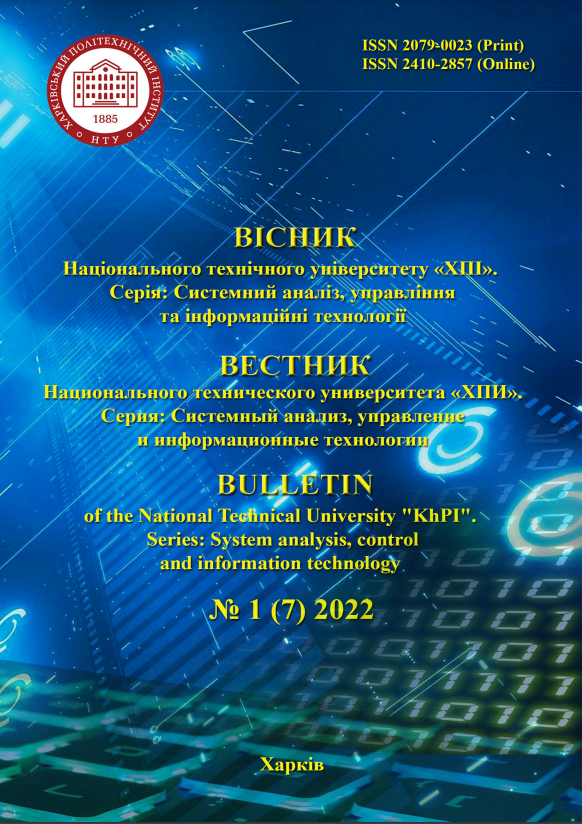TEMPLATE-BASED MODEL FOR SHORT-TERM FORECASTING OF THE NUMBER OF TRANSACTIONS IN RETAIL CLOTHING STORES
DOI:
https://doi.org/10.20998/2079-0023.2022.01.08Keywords:
number of transactions, time series, pattern-based model, short-term forecasting methods, customer number forecasting, adaptive forecasting modelAbstract
Obtaining predictive values of indicators based on historical data represented by time series plays a crucial role in making business decisions in various industries. One of these areas of application is the task of predicting the number of transactions in retail stores in order to optimally plan the working hours of employees and achieve maximum customer satisfaction with the quality of service. The choice of an appropriate time series forecasting model depends on the forecast horizon, as well as the characteristics of the time series, namely trend, seasonality, cyclicality, and irregularity. Traditional time series analysis and forecasting methods are designed to handle a single seasonality in a time series, but in the presence of multiple seasonality, these methods do not work satisfactorily. The use of time series decomposition methods is characterized by computational complexity. The use of machine learning methods is also not always advisable for a number of different reasons. Thus, it is necessary to use simple adaptive models, based on selected patterns, for recurring seasonal data of complex structure. The main goal of this article is to develop a successful adaptive model and propose methods for using it for short-term forecasting of the number of transactions based on time series data. For estimation purposes, a set of hourly time series of the number of customers (transactions) of some retail chain stores, characterized by multiple seasonality, is used. The results of computational experiments show that the proposed template-based model is quite effective for obtaining short-term predictive values. This model, characterized by simplicity, intuitiveness and a minimum number of tuning parameters, can actually be applied to any area of data represented by time series.
References
Naim I., Mahara T., Idrisi A. R. Effective Short-Term Forecasting for Daily Time Series with Complex Seasonal Patterns. Proc. Comp. Sci. 2018, vol. 132, pp. 1832–1841.
Snityuk V. Ye. Prognozuvannya. Modeli. Metody. Algorytmy [Forecasting. Models. Methods. Algorithms]. Кyiv: Maklaut Publ., 2008. 364 p.
Golyandina N., Usevich K. 2D-extension of Singular Spectrum Analysis: algorithm and elements of theory. In: Matrix Methods: Theory, Algorithms and Applications. World Scientific Publishing, 2010, pp. 449–473.
Haghbin H., Najibi S. M., Mahmoudvand R., Trinka J., Madoliat M. Functional singular spectrum analysis. Stat. 2021, vol. 10, issue 1. e330.
Bodyansiy Ye. V., Vorobyov S. A., Kostiuk O. V., Lyubchyk L. M. Fil’traciya i prognozirovanie trend-sezonnyh vremennyh fyadov na osnove iscusstvennyh neironnyh setey [Filtering and forecasting trend-seasonal time series based on artificial neural networks]. Radioelectronika i informatika. 1998, no. 3, pp. 76–83.
Xiong L., Liu X., Liu Y. Decaying DC and Harmonic Components Detection for Absorbing Impact Load Currents in Weak Grids. IEEE Transactions on Power Delivery. 2020, vol. 36, no. 3, pp. 1907– 1910.
Beltran-Carbajal F., Tapia-Olvera R. An adaptive neural online estimation approach of harmonic components. Electric Power Systems Research. 2020, vol. 186. 106406.
Gheyas I. A., Smith L. S. A Neural Network Approach to Time Series Forecasting. Lecture Notes in Engineering and Computer Science. 2009, vol. 2177, pp. 1292–1296.
Bodyansiy Ye. V., Tishcenko O. K., Kopaliani D. S. Prognozuvannya bagatovymirnyh nestazionarnyh chasovyh rydiv na osnovi adaptyvnoyi neo-fazzi-modeli [Prediction of multidimensional nonstationary time series based on the adaptive neo-fazzi model]. Compyuterni nauky ta informaciyni tehnologii. 2012, no. 744, pp. 312–118.
Korablev N. M., Ivashchenko G. S. Primenenie modeli klonalnogo otbora, ispolzuyushchei vivod po pretsedentam, dlya prognozirovaniya vremennikh ryadov [Application of clonal selection model using precedent inference to predict time series]. Bionika intelekta. 2013, no. 1 (80), pp. 108–111.
Hooi B., Liu S., Smailagic A., Faloutsos C. BEATLEX: Summarizing and Forecasting Time Series with Patterns. Machine Learning and Knowledge Discovery in Databases. Lecture Notes in Computer Science. Vol. 10535. Cham, Springer. pp. 3–19.
Grinberg G. Stock market statistical data analysis for prices forecasting and trading decision support. Proc. of int. conf. “Theory and practice of science”. 2021, vol.58, pp. 283–288.
Downloads
Published
How to Cite
Issue
Section
License
LicenseAuthors who publish with this journal agree to the following terms:
- Authors retain copyright and grant the journal right of first publication with the work simultaneously licensed under a Creative Commons Attribution License that allows others to share the work with an acknowledgement of the work's authorship and initial publication in this journal.
- Authors are able to enter into separate, additional contractual arrangements for the non-exclusive distribution of the journal's published version of the work (e.g., post it to an institutional repository or publish it in a book), with an acknowledgement of its initial publication in this journal.
- Authors are permitted and encouraged to post their work online (e.g., in institutional repositories or on their website) prior to and during the submission process, as it can lead to productive exchanges, as well as earlier and greater citation of published work (See The Effect of Open Access).


